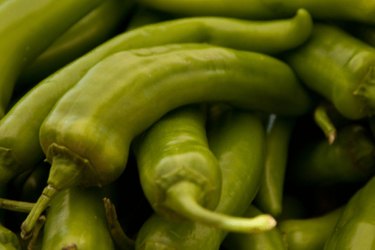
Vegetable gardening according to season takes a bit of advanced planning to ensure that the crops are ready for harvest during the appropriate time and also to ensure that each plant is successful in bearing fruit. Planting vegetables out of season without the use of a greenhouse or special equipment most often results in failure. Several vegetables are hardy to more than one season, and planting these throughout the year in the vegetable garden provides one with fresh homegrown food during the entire growing season. Other varieties do well only in certain climates or conditions, and one or two harvests is all that is often possible.
Spring
Video of the Day
In the spring, vegetable gardeners are busy preparing their gardenbeds for seeds, seedlings and transplants of cool season vegetables. Some of the more common types to plants to grow during this season include radishes, lettuce, broccoli, cabbage, turnips, onions and carrots. All need well-draining soil and plenty of moisture to ensure optimal growth habits. Adding a bit of composted horse manure or other organic matter to the garden bed during this time helps increase nutrients and allows for a better harvest. Cool season spring vegetables can be planted as soon as the ground can be worked or after the threat of frost has passed.
Video of the Day
Summer
Summer vegetable gardening is rewarding for many gardeners, and the harvest that results from summer planting is often bountiful. Vegetables such as tomatoes, summer squash, peppers, carrots, potatoes and lettuce, as well an abundance of herbs, grow best during this season. Some spring vegetables may be extended into the summer if they are heat-resistant varieties or if they are moved and planted to a less sunnier part of the garden to avoid getting too hot.
Fall
The beginning of fall marks the final stretch for most home vegetable gardens, and crops such as pumpkins, winter squash, lettuce, cabbages and turnips dominate the harvest during this time. Summer crops may also be extended provided the weather allows. Some regions may not be suitable for a fall harvest, so contact a local gardening center for local recommendations.
Winter
Winter vegetable gardening is not possible in colder regions without the use of a greenhouse or cold frame, but in milder climates many cool season vegetables can continue to be planted and harvested during this time. Lettuce, cabbage and broccoli are all frost-hardy vegetables that do well unless temperatures dip below 20 degrees Fahrenheit. If a cold spell such as this occurs, move plants to an enclosed patio, or cover with an appropriate covering until it passes. Container gardening during this time makes it easier to move vegetables when necessary.
- University of Illinois Extension: Extension; Vegetable Directory; Ron Wolford and Drusilla Banks
- Cornell University Extension: Home Gardening: Vegetable Growing Guide; 2006
- Ohio State University: College of Food, Agricultural and Environmental Sciences; Yard and Garden; Vegetables
- Texas A&M University Extension: The New USDA Plant Hardiness Map; Dan Lineberger and Jerrry Parsons